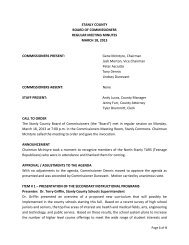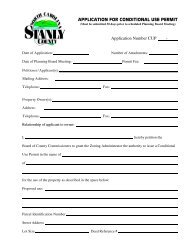Land Use Plan – 2002 - Stanly County, North Carolina
Land Use Plan – 2002 - Stanly County, North Carolina
Land Use Plan – 2002 - Stanly County, North Carolina
You also want an ePaper? Increase the reach of your titles
YUMPU automatically turns print PDFs into web optimized ePapers that Google loves.
STANLY COUNTY<br />
considered, particularly when a given development includes a healthy mix of land uses and/or<br />
includes community facilities such as a school.<br />
Most of the primary growth areas for the nine cities was drawn in cooperation with<br />
representatives from the cities. As a result, the size of the primary growth areas reflect the<br />
specific wishes and needs of each community as well as the realities of growth and development<br />
patterns some of these communities are already experiencing. Although there are some<br />
exceptions, the position of the boundaries of the primary growth areas corresponds well to the<br />
existing ETJs exercised by six of the nine incorporated cities. Albemarle and Badin do not<br />
presently exercise an ETJs. The long-range recommendations were completed before the<br />
incorporation of the Town of Red Cross.<br />
In addition to encouraging growth around the nine incorporated cities, primary growth areas are<br />
also proposed for the following unincorporated towns and crossroad settlements:<br />
Aquadale<br />
Endy<br />
Finger<br />
Frog Pond<br />
Millingport<br />
Misenheimer<br />
Plyler<br />
St. Martin<br />
While the size of the primary growth areas for these towns is considerably smaller than those of<br />
the incorporated cities, placing primary growth areas in these areas encourages the moderate<br />
continuation of existing development patterns already found in these places. Also, encouraging<br />
development in these towns and crossroad settlements, all of which are located major roadway<br />
corridors in the county (i.e., NC 24/27, NC 73, NC 49, US 52, St. Martin Road) allows for rural<br />
commercial development at strategic places along these important transportation roads.<br />
It should be noted here that a portion of the primary growth areas lies within the ETJs. For<br />
example, most of the primary growth area surrounding Norwood, Oakboro, and Richfield are<br />
well within their respective ETJs. As such these areas are theoretically outside the <strong>Land</strong> <strong>Use</strong><br />
<strong>Plan</strong> study area and the jurisdiction of <strong>County</strong> <strong>Plan</strong>ning Commission and Board of <strong>County</strong><br />
Commissioners.<br />
Secondary Growth Area<br />
The secondary growth area includes land expected to be consumed by development in the<br />
period beginning 10 years after the adoption of the <strong>Stanly</strong> <strong>County</strong> <strong>Land</strong> <strong>Use</strong> <strong>Plan</strong>. Development<br />
within the secondary growth area, while encouraged in the long-range, is discouraged in the zero<br />
to 10-year period. Once development saturates 75 percent of the land area of the primary<br />
growth area for a specific city or town, as-of-right development in the secondary growth area<br />
may proceed.<br />
While similar to the primary growth area in terms of land use, development densities<br />
recommended for this portion of the study area are lower than those of the primary growth area.<br />
Residential development densities recommended for the secondary growth area ranges from<br />
two to four dwelling units per acre. In some portions of the secondary growth area densities may<br />
be even lower. This is consistent with the fact that a portion of the secondary growth area may<br />
not be served by utilities. Further, the secondary growth area, because it is situated farther from<br />
the center of each respective community, will not be supported by the same level of community<br />
services as the primary growth area and existing incorporated areas.<br />
The conservation development model is encouraged to be used in the secondary growth area.<br />
This recognizes that a portion of the secondary growth area may be located in areas of the<br />
county where existing natural resources, farms, or other resources are worthy of preservation.<br />
To encourage use of the conservation development model, density bonuses should be<br />
investigated.<br />
<strong>Land</strong> <strong>Use</strong> <strong>Plan</strong> 6-12 6/02






